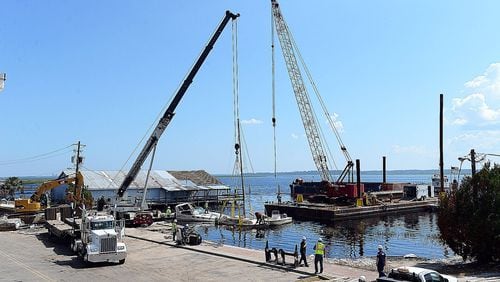It’s been a rough few years for residents living on Georgia’s coast.
Two named storms and higher than usual tides have eroded the shore line, damaged properties and devastated some communities.
“It was catastrophic,” Saint Mary’s City Manager John Holman said of Tropical Storm Irma’s damage in September. “It’s going to take years for us to get back to what it was.”
More than three months after the storm, the coast is in varying stages of recovery.
At first glance, things appear to be back to normal 0n Jekyll Island, the state-owned land in Glynn County. But much of the sand has been washed away, along with the barriers that officials say help keep the shoreline in place.
The main drag on Tybee Island also appears much like it was before the storm, though in addition to the eroded beach, several homeowners are still dealing with repairing or rebuilding their damaged homes tucked away in neighborhoods.
In Saint Mary’s — the hardest-hit part of Georgia’s coast during Irma — crews are close to clearing away all the debris left behind. However, the rebuilding of structures, including docks and public gathering places, has yet to begin.
Four coastal counties combined for at least $58 million worth of insured damage out of about $680 million claimed statewide, according to the state insurance commissioner. That figure does not include the millions of dollars in damage to property that wasn’t insured.
All along the coast, communities are rebuilding with an eye to the next big storm.
Saint Mary’s plans to rebuild its structures with sturdier materials. On Jekyll Island, officials want to restore the large rock barriers along the beach that have been washed away by storms. Tybee Island’s mayor wants to bring sand in to renourish the coast and build more dunes.
Though the Georgia coast had not taken a direct hit from a hurricane in more than 100 years, weathering two damaging storms in less than a year has residents and officials on edge over what 2018 could bring.
The number of storms in the Atlantic Ocean seems to have been increasing in recent years. That’s something that Jekyll Island Authority board member Joe Wilkinson said has people on edge.
“If you’re on the coast, it’s going to happen eventually,” said Wilkinson, a former Georgia House member who lives on St. Simons Island. “It’s just a cycle — nature’s cycle.”
For each, the challenge is to get as much as possible in place before the 2018 hurricane season begins June 1.
‘Key word is resiliency’
In Saint Mary’s, almost all the piers, docks and boat ramps were wiped out, causing the city to lose its ability to ferry visitors to Cumberland Island National Park.
The ferry service was out of commission for two months before a second dock a few blocks away could be built to take tourists to the park. Those two months were during what Holman said was the city’s peak season that draws about 60,000 people annually to visit Saint Mary’s bed and breakfasts, restaurants and shops.
“Those visitors bring in revenue for city businesses,” he said, “and if they’re getting revenue, the city benefits.”
Terry Landreth, the owner of Camden Bike Shop, said his business made about 20 percent less in 2017 than in 2016.
“We just want to get back to normal,” Landreth said. “We’re not a big tourist destination here. Sixty-thousand visitors is not a lot in your tourism dollars, but every dollar is important in that case. When you’re disrupted like that, every bit is important.”
After two months, the U.S. Army Corps of Engineers allowed the city to repair the Gilman Dock to allow visitors to travel to Cumberland Island. That dock is about three blocks away from where the ferry usually departs.
Irma also destroyed the marina that docked several private boats, many that crews had to pull out of the water after the storm. One remains stranded in the marsh, officials said.
Businesses on the waterfront reopened quickly, but no one was coming to patronize them other than cleaning crews and insurance assessors who stopped for lunch while in town, Holman said.
Now, the city is beginning the rebuilding process.
The historic cemetery, seawalls, sidewalks, roadways and the roofs of some municipal buildings also were damaged. Holman said the city hopes to have the original boat ramp working by July to operate the ferry to Cumberland Island.
Cleanup and rebuilding so far have cost about $1.5 million, and officials said the city estimates it could cost up to $4 million when all is said and done.
Holman hopes in time the waterfront will be even better — and sturdier — than it was.
“My key word is resiliency,” Holman said. “That’s what we’re working toward now. … (Structures) are being built so they are better able to withstand future storms.”
Even with the preparation, Holman said it’s nearly impossible to be ready for a storm like Irma.
“I don’t know how you mitigate for Irma,” he said. “What you do is plan and train people for emergencies. But during an Irma storm, you just get out of the way and come back, repair and restore it as you can.”
‘Three times in two years’
Strong rains from Irma coinciding with a “king tide” — an exceptionally high tide that occurs during a full moon — left almost all the homes on Tybee Island that had not been elevated above ground level under some amount of water.
Susan Hill, who said she’s opted not to raise her home on Lewis Avenue because her husband has a disability, said she heeded the mandatory evacuation of her house that sides on a tidal creek.
“The tide comes up to our backyard every day,” she said. “But including tidal surge that came in with Irma, the water came in, filled up the house and went out.”
About four feet of drywall has been cut out throughout the house to be replaced. Most of the large appliances were lost, as well as furniture and all the low cabinets. And more than three months later, work is still being done to get the home back in order, Hill said.
“Before that we hadn’t seen much flooding. We’d been very blessed,” Hill said. “There are some folk that were flooded for the king tide, for (Hurricane) Matthew and for Irma. That was three times in two years.”
Tybee Island Mayor Jason Buelterman said there were areas of the island that flooded during Matthew in October 2016 that were hit even worse in 2017. Other properties, such as Hill’s home, were spared by Matthew but saw damage from Irma.
Most of the rebuilding is being done by private homeowners, but Buelterman said the city is fighting to replenish its beaches. Getting federal approval takes time.
Buelterman said if the beaches are renourished — meaning sand from elsewhere is brought to a shoreline that has eroded — and more sand dunes are built, it could keep water from freely flowing into the streets, shops and homes on Tybee Island.
“Building sand dunes is the best way to protect us from those surges,” he said.
Another way to keep residents safe during storms and throughout the year would be to renovate U.S. 80 — the causeway that connects the island with the mainland.
During the storm, and a few other times in the past year, water flooded the causeway and stranded Tybee residents. Buelterman has asked the state to widen the road and raise two bridges between Savannah and Tybee.
“I’ve been mayor for 12 years, and this is something I’ve been trying to get done for 12 years,” he said. “And anecdotally, it seems to be happening more often.”
According to the state Department of Transportation, construction is scheduled to begin in 2026.
Whether it’s sand dunes or a renovated causeway, Hill said island residents actively need to prepare for the next big storm.
“This is just something that we have to work through and do our due diligence and be as proactive as we can,” she said, “because we know that this is something that can happen again.”
‘Eye-opener’
Someone who doesn’t live on the state-owned Jekyll Island might never know there had been a storm through the area just a few months earlier.
Like Tybee, Jekyll Island suffered large amounts of beach erosion, but officials there are looking at different ways to keep its sand in place.
Irma’s winds washed away many of the rock barriers that were put in place in the 1960s after Hurricane Dora. Officials with the Jekyll Island Authority are rebuilding those barriers.
In October, Gov. Nathan Deal moved $4 million from his emergency fund to repair damage to the barriers caused by Irma and Matthew.
“There is some maintenance that should have been done decades ago, but we’re doing it now,” said Ben Carswell, the authority’s director of conservation.
Elsewhere in Glynn County, Irma damaged lots on the Sea Island “spit,” where the company had to halt marketing of its proposed upscale housing on the land.
St. Simons had some beach erosion and debris that needed to be cleaned. Homeowners on St. Simons and throughout the county are still waiting on professionals to be available to repair homes damaged by flooding.
“They’ve been pulling down the Sheetrock and disposing of it, but they don’t have enough contractors to come in and put up the new walls,” Wilkinson said.
The storm also changed Driftwood Beach on Jekyll Island. Wind and water lifted many of the iconic petrified trees from where they once were. Often listed as one of the country’s most romantic beaches — Coastal Living magazine called it “hauntingly beautiful” — the spot on Jekyll Island has been the site of many wedding proposals, authority spokeswoman Jessica Scott said.
“People are sort of making a game of it,” she said. “They try to come and find their favorite tree.”
Between the severe beach erosion and the rearranging of the massive trees on Driftwood Beach, Carswell called Irma an “eye-opener.”
“If we actually do see hurricane force conditions, we need to be prepared for how we respond and recover,” he said. “We need to be as equipped as we can be for what comes and hope for the best.”
About the Author







